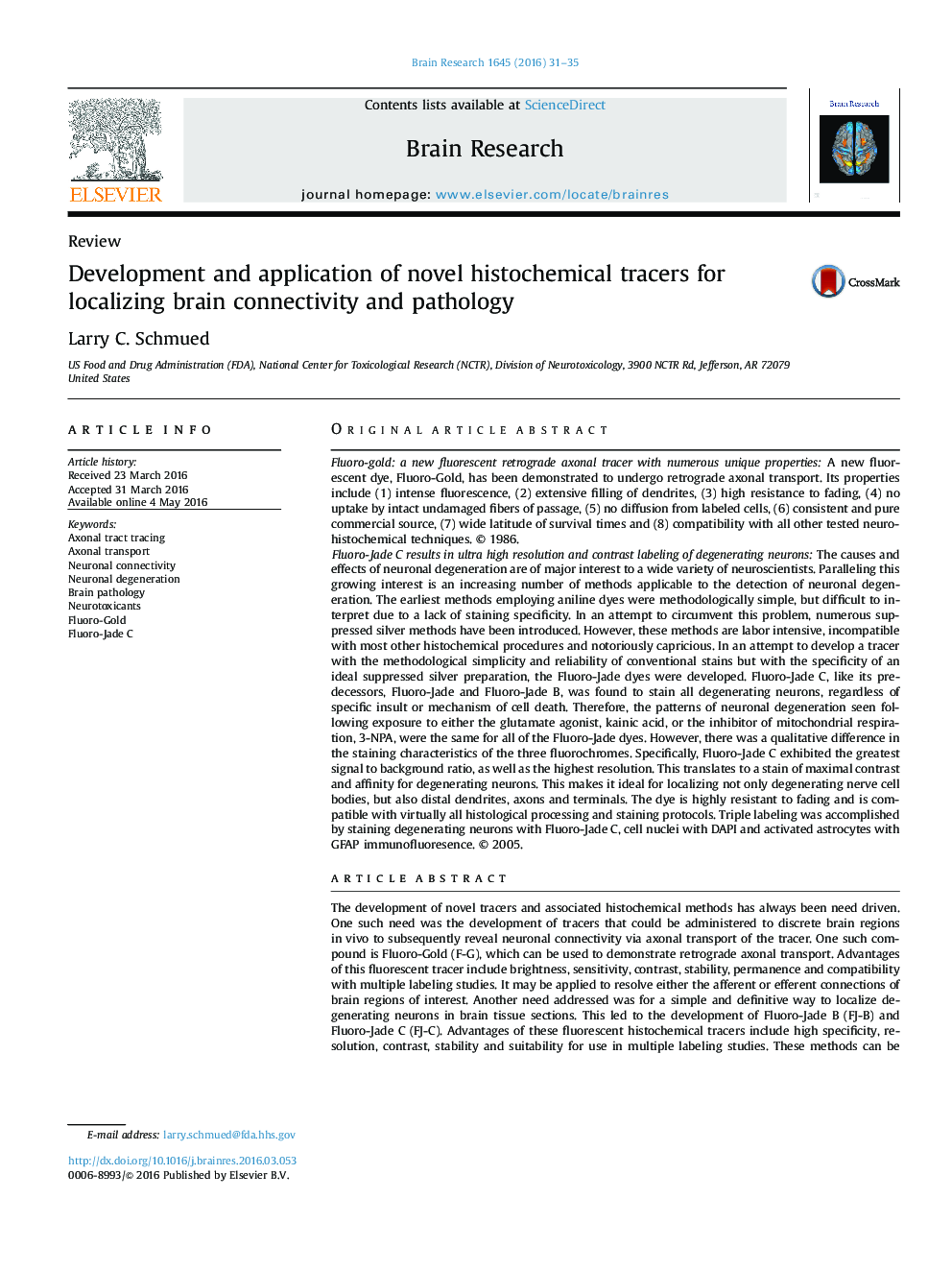| کد مقاله | کد نشریه | سال انتشار | مقاله انگلیسی | نسخه تمام متن |
|---|---|---|---|---|
| 6262485 | 1613797 | 2016 | 5 صفحه PDF | دانلود رایگان |
Original article abstractFluoro-gold: a new fluorescent retrograde axonal tracer with numerous unique propertiesA new fluorescent dye, Fluoro-Gold, has been demonstrated to undergo retrograde axonal transport. Its properties include (1) intense fluorescence, (2) extensive filling of dendrites, (3) high resistance to fading, (4) no uptake by intact undamaged fibers of passage, (5) no diffusion from labeled cells, (6) consistent and pure commercial source, (7) wide latitude of survival times and (8) compatibility with all other tested neuro-histochemical techniques. © 1986.Fluoro-Jade C results in ultra high resolution and contrast labeling of degenerating neurons: The causes and effects of neuronal degeneration are of major interest to a wide variety of neuroscientists. Paralleling this growing interest is an increasing number of methods applicable to the detection of neuronal degeneration. The earliest methods employing aniline dyes were methodologically simple, but difficult to interpret due to a lack of staining specificity. In an attempt to circumvent this problem, numerous suppressed silver methods have been introduced. However, these methods are labor intensive, incompatible with most other histochemical procedures and notoriously capricious. In an attempt to develop a tracer with the methodological simplicity and reliability of conventional stains but with the specificity of an ideal suppressed silver preparation, the Fluoro-Jade dyes were developed. Fluoro-Jade C, like its predecessors, Fluoro-Jade and Fluoro-Jade B, was found to stain all degenerating neurons, regardless of specific insult or mechanism of cell death. Therefore, the patterns of neuronal degeneration seen following exposure to either the glutamate agonist, kainic acid, or the inhibitor of mitochondrial respiration, 3-NPA, were the same for all of the Fluoro-Jade dyes. However, there was a qualitative difference in the staining characteristics of the three fluorochromes. Specifically, Fluoro-Jade C exhibited the greatest signal to background ratio, as well as the highest resolution. This translates to a stain of maximal contrast and affinity for degenerating neurons. This makes it ideal for localizing not only degenerating nerve cell bodies, but also distal dendrites, axons and terminals. The dye is highly resistant to fading and is compatible with virtually all histological processing and staining protocols. Triple labeling was accomplished by staining degenerating neurons with Fluoro-Jade C, cell nuclei with DAPI and activated astrocytes with GFAP immunofluoresence. © 2005.article abstractThe development of novel tracers and associated histochemical methods has always been need driven. One such need was the development of tracers that could be administered to discrete brain regions in vivo to subsequently reveal neuronal connectivity via axonal transport of the tracer. One such compound is Fluoro-Gold (F-G), which can be used to demonstrate retrograde axonal transport. Advantages of this fluorescent tracer include brightness, sensitivity, contrast, stability, permanence and compatibility with multiple labeling studies. It may be applied to resolve either the afferent or efferent connections of brain regions of interest. Another need addressed was for a simple and definitive way to localize degenerating neurons in brain tissue sections. This led to the development of Fluoro-Jade B (FJ-B) and Fluoro-Jade C (FJ-C). Advantages of these fluorescent histochemical tracers include high specificity, resolution, contrast, stability and suitability for use in multiple labeling studies. These methods can be applied to detect both apoptotic and necrotic neuronal degeneration following a variety of insults including physical trauma, neurodegenerative disease and a wide variety of neurotoxicants.This article is part of a Special Issue entitled SI:50th Anniversary Issue.
Journal: Brain Research - Volume 1645, 15 August 2016, Pages 31-35
